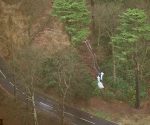The London Bridge incident: the City of London/British Military Intelligence amalgam at low ebb?
There’s no doubt that it is significant that the latest supposed terror attack in London was a pathetic affair in contrast with the spectaculars that have been pulled off in the past. And there’s no doubt that it is not without significance that the reedy weakness of the incident doesn’t register in alternative media that covers it, nor does it dent the relentless grandiosity of its treatment in corporate-media. The incident was so curiously constrained in relation to others of the same ilk from the past 20 years that the Queen was required to make an unusual contribution, as part of a subconsciously received, unspoken official explanation, and commend the actions of a number of have-a-go-heroes: you see, the smallness of the event was due to the swift incapacitation of the culprit. As hinted at above, there is subsequently no appetite to question what appears by every one’s own eyes to be true.
Of course, there were moments in the attack that are unknown to the general public, except what has been conveyed through controlled media, and a filter that requires no questions to be asked. So, what does the public know about this incident? Answer: that an ex-convict, at some point while he was attending a conference on post-prison rehabilitation, started attacking fellow attendees with knives or a knife. He was somehow fended off into the street, where he was harangued into travelling a number of yards along London Bridge, and a group of men fought him to the ground and restrained him; let’s not call these people general members of the public who became involved in the street, because it appears as if they were crowd that spilled out from the venue hosting the conference. Very quickly, armed police arrived, so that the incident took no longer than eight minutes. Police, with the evident intent of shooting the perpetrator as soon as possible, ordered the men to clear out of the way, and in one case, someone was dragged off by a cop. As soon as the police had a clear view, the knifeman was shot dead.
The public have also been subjected to a good deal of aftermath turmoil, where the incident has been used as a political football, with blame and recrimination being cast from one side of the spectrum to the other. The knifeman, Usman Khan, was supposedly released early from prison after being convicted of a terror offence. As a result there has been a heated debate about appropriate prison sentences with fewer chances of remission, especially for terrorists. Tellingly, there has been no concern about summary execution of a criminal suspect; Khan was supposedly wearing a toy suicide belt, which is not justification to shoot him, let alone kill him, especially after he had been pinned down and rendered immobile. In fact the lack of abhorrence about police action in blanket corporate-media coverage, and indeed in terms of political response, is disturbing to say the least – and forms the point at which we depart from the simplistic understanding of the incident that the general public must be encouraged to have.
The political reaction to the new London Bridge attack points to the incident being a false flag attack. Obviously, its purpose was to create a talking point by which there could be an injection of energy into an otherwise torpid election campaign. Moreover, that the controversy is selective, where no consideration at all is given to arbitrary and unlawful powers of the state, indicates total control of the reaction for maximised manipulation of public opinion – or at least an attempt at it. In such a context, the generating crisis has very little chance of being an organic one.
However, while seasoned event sceptics can read reaction just as someone looking at the sky can tell the weather, it is flimsy evidence on its own – and indeed no proof of anything for many people. But then, these things are not supposed to throw up incontrovertible proof. Instead, however, there is the production of the weight of evidence which can persuade its examiners to establish something approaching truth – at least something more like it than comprises the flat dimension of general public understanding – and although it was a small event, this latest false flag produces plenty of material by which to judge it.
Firstly, Usman Khan was jailed in 2012 after admitting to preparing a terrorist act. Fortunately, the author covered this conviction in an article that appeared at the predecessor of this site, and was republished in these pages (here). The inconvenient truth of this matter is that the Crown probably would not have won a trial to convict Khan,; as such his admission of the crime was exceedingly convenient. Khan, then, is that common sort of terrorist that is known to the intelligence agencies prior to the perpetration of his crime; in fact, he is the exemplar of this variety, because he was involved in an entrapment operation. To reinforce the concept of Khan as a terrorist, however, the corporate-media has been reporting that ISIS has claimed responsibility for the attack, as if Khan was an ISIS operative – indeed, the Mirror ran a story about a school friend who “was shocked when just a year after leaving school, he saw him [Khan] preaching hate on the streets of Stoke-on-Trent, under the black flag of ISIS.” This would be a feat indeed, given that ISIS did not exist before 2014, and Khan has been in jail since 2012. Indeed, if Khan was released in 2018 at the age of 28, the Mirror’s story is fully Orwellian. Of course, long term FBEL readers would understand that any claims of ISIS executing a terror attack might as well instead be attributed to the Sasquatch: in truth, “our boys” are ISIS. Nevertheless, in another prong of this demonization, Khan is linked with Anjem Choudary – infamously a supposed Islamic hate cleric. And yet, this is not safe either, for Choudary is a character that MI5 repeatedly protected from prosecution, action that inevitably elicited suspicions that he was a military intelligence asset.
The scandal about Khan’s early release is also a red herring – or, the detail is being misrepresented† so as to become a scandal, and provide grist for the invigoration of election debate. The Off-Guardian site noticed that the record of the sentencing ruling meted out to Khan is no longer available to view online at the official source, however, Luikkerland (this site’s predecessor) recorded that Khan was at first given an “indeterminate sentence with a minimum term of eight years.” Notice that in its attempt to answer the question why Khan was released early, The Guardian fails to supply the duration of what turned out to be a preliminary sentence – and no wonder if there is a concerted effort across British politics to make the public understand incorrectly that Khan cheated the system. He did not. The Guardian goes on to inform that Khan appealed his sentence, which he won so that he was handed a determinate, or fixed, sentence, “of 16 years, extended by a further five on licence. That meant he would automatically be allowed out after eight years, without the involvement of the parole board.”
Now, the reader needs to appreciate that with a determinate sentence, release is automatic halfway through without reference to a parole review. This is not Khan’s fault. Previously, with his indeterminate sentence, Khan would have had to serve eight years before being eligible for parole – and so one can see how it was that he won his appeal. Perhaps a better way to put this is that things were arranged so that Khan could leave his period of incarceration without the prison authorities understanding how his term had affected him. This means that there was an opportunity for Khan to become radicalised in jail with no means to test it, and thus prevent his release. Ultimately, what needs to be appreciated is that there is no early release scandal: Khan was always due to be released after eight years, albeit at first with a parole review which, if he was a normal prisoner, he might have been expected to pass. Arguably, it was because he wasn’t a normal prisoner that the terms of imprisonment changed. So, the scandal here is that the justice system is clearly open to abuse by military intelligence – but expect disgust of this fact not to travel beyond these pages.
Further clues that add to the substance of the weight of evidence for a false flag are to do with the meeting at which Khan was supposedly in attendance, and the place where it was held. It was a convention run by Cambridge University’s criminal science department, or at least a sub-department of it, which has conceived a program for prisoner rehabilitation called Learning Together. Without going too much into the detail, this is a scheme that brings criminology students together with criminals, or as appears to be in this case ex-convicts, in an environment which allows the former group first hand exposure to the latter as it is given an opportunity to access the academic material that informs the students. Fundamentally, the programme is about behaviour modification.
Now, it transpired that the two people who were killed in the incident were Cambridge University graduates, one of which was a co-ordinator in relation to the Learning Together programme. The venue of the incident was Fishmongers’ Hall: the headquarters of the Worshipful Company of Fishmongers – a component of the freemasonic City of London that, with military intelligence as its wide reaching tentacle of control, actually rules Britain (as discussed hereabouts previously). Moreover, the reader probably knows that Cambridge University has traditionally been fertile ground for recruitment into military intelligence – so the confluence of factors from which a terror attack was generated are altogether too coincidental to pass without remark.
We find that the antagonist is a “terrorist”, whose particular circumstances are perfect for controversy during an election campaign; who was jailed in an entrapment operation – so wasn’t really a terrorist, and also perhaps, therefore, not even capable of being one before he was imprisoned; who was allowed to avoid testing to see if prison had radicalised him during the course of his term of sentence. Despite this, a team of Cambridge University behavioural modification scientists evidently had an interest in Khan’s state of mind, hence his invite to a gathering in the City of London.
The venue from whence Khan erupted into violence was a nest of freemasonry that day hosting post-graduates connected to that aforementioned Cambridge University behaviour modification programme. It is from this place that Khan was forced into the street in order that the public would get to see his summary execution, handily filmed by a passerby on a pavement that was curiously devoid of other bodies. Curiously, in this age where there is very little video footage of terror attacks, this piece survived the usual capturing and containment by police, and found its way onto social media – meaning that it is meant to be there. There should be no wonder at this, given that this footage is the only piece of evidence that the public has that informs it that the incident happened. That’s not to say that the event was a hoax, rather Khan was wound up, and let go to do his worst. Ultimately, the plan entailed his being seen to be a terrorist, which meant being persuaded (by force) to leave the building.
Given that the incident was terminated in a matter of minutes, the images of empty pavement on London Bridge possibly suggest that police may have had expected spill out from Fishmongers’ Hall, and had earlier made the stage secure from passers-by whose involvement would not be required. The inquest yet to come will no doubt confirm or disprove this, but it appears that the armed officers who shot Khan were the Corporation’s own: the City of London police. While corporate-media talks of a joint reaction also involving the Metropolitan Police, it is the City of London police that reportedly took the first call, and thus, supposedly, were the first alerted. Even so, it is pretty obvious that the execution squad must have been self-summoning from the immediate area going by the promptness by which they appeared.
And so, the impression that one can’t help getting is of a little event, constricted into a few square yards in the city, launched out of a guild hall from whence supposed civilians evicted the perpetrator, using corporation cops to end it quickly without the first thought about the law that should apply to Khan and that guarantees him certain rights. Dead men tell no tales. There was no great streetscape that we have now become used to, where players strut upon a stage that would have required copious numbers of police road blocks to seal off. There was no complexity in this attack: no necessity for a tourist to be flung into the Thames. There wasn’t the usual string of wounded – with just two dead, and these behind closed doors – and there definitely was no litter of incriminating material – even in images that show the culprit unattended in the place where he died. It is a very unusual false flag attack indeed, and as such it is very surprising, given that even the Salih Khater “spasm”, which was perhaps the feeblest false flag attack in the last 20 years, at least produced the spectacle of skittled cyclists.
Indeed, given that this very limited London Bridge attack does come on the heels, albeit very slowly, of the incompetently executed Salih Khater spasm, the author cannot help but wonder if anything is the matter with military intelligence that affects its ability to produce what it might consider essential domestic state craft. Consider how in February of this year, the Independent reported that “400 people ‘of national security concern’ are believed to have returned [to Britain] from conflicts in Syria and Iraq.” Of these, 90% were considered to be unprosecuted terror threats, and while the public is no doubt supposed to believe that these returnees are not troubled by law enforcement for technical or economic reasons, it would be more likely that, as redeployed British mercenary assets, they are deliberately left alone. Khan is not one of these characters; he has been in prison since 2012, unable to visit Syria or Iraq to gain credentials. If the planners of this false flag wanted a rigorous ISIS connection, why use Khan instead of one of these other assets?
The author remembers something said in 2018 by President Assad of Syria (or a paraphrasing of it as cited in a previous FBEL article) to the effect that the countries who were interested in the survival or reinvigoration of terrorists in Syria for a bargaining chip “will only succeed in wasting the capabilities of the peoples of these countries”. The author took this to mean that efforts in Syria, maintained even in spite of recurring defeat, would drain British blood and treasure, and first began to think about what the too high a price for Syria could mean for the grip of military intelligence domestically.
Syria as a meat grinder for British capability would not just be about making low level assets too valuable to be sacrificed in a little job of domestic state craft. Regular readers of FBEL will be familiar with a report in the first half of 2018 regarding the capture of British military and military intelligence as it was embedded with its proxy forces as these found themselves surprised by blitzkrieging Syrian Arab Army.
More recently (November 16th), the author was intrigued by a story at Southfront which asked if the UK was preparing an evacuation of its intelligence personnel from Idlib in Syria. The article basically constituted some speculation about Britain approaching Russia to facilitate withdrawal of “its intelligence officers and military advisers involved in propaganda operations and training of militants”. Fascinatingly, the story appeared only days after news came of the death of James Le Mesurier. Now, the author was not convinced that the details of Le Mesurier’s death were necessarily true – for operational reasons, i.e. not giving away his actual location at the time of his death. The Turks, at least as it appears to the author, are evidently not averse to covering up on behalf of the British‡. And while Le Mesurier was the identifiable front for the founding of the White Helmets (the propaganda operations and militants of the Southfront report), he had been a British Army officer, and the Russians had outed him as MI6. If truth be known, the consumers of corporate-media are certainly not amongst those who do – if Le Mesurier had more active and closer connections to British operations in Idlib, which is certainly not safe from Russian and Syrian bombing even in moments of static front lines, then it wouldn’t be on Joe Public’s radar.
At the same time as the author wonders about issues of manpower affecting capability in terms of planning, overseeing, and carrying it out, he also wonders if there is a critical problem in terms of doubt in planners regarding the assured cooperation of personnel necessary for the successful execution of domestic state craft. It is a difficult idea to express, so it might be easier to repeat something that was aired earlier:
The author has a particular interest in the morale of the “beat bobbies” of the Metropolitan Police, having knowledge as he does of the Westminster Bridge inquest (via the transcripts -no mysticism involved), where it appears that there could be a belief amongst his peers (although there is no way of telling how far this would extend into the force if it were true) that PC Keith Palmer was shot in the head despite his supposed assailant only having knives.
It was “beat bobbies” who found themselves in danger of death again when Salih Khater careered into a Westminster Palace access lane, and came to a crashing halt at the barrier in front of which they previously, only moments before, had been standing. At the time, the author wrote how it was in keeping and indicative of the way that their masters could care less if police who were decent human beings came out of these false flags alive or dead – that they were “as dispensable as is the public” – and so that such people had no cause to be loyal, but in fact should even act to sabotage “psychological operations that push political agendas”. Of course, rank and file police who understand their vulnerability at the expense of disinterested grander political designs wouldn’t need to read FBEL; they would be brought to their own conclusions by their own immediate experience. The question is, even before we could claim to see evidence of it, would it be realistic to hope for a culture of insubordination amongst police so that false flag terror was always rendered less effective and more exposed for its true nature whenever it was attempted. Time will tell; the next incident is undoubtedly being conceived even as the reader finishes this article.
† It is true that the numbers don’t add up, but the corporate media is insisting that Khan had been released automatically half way through his sentence. He was out on licence, released in December 2018, having served nearly 7 years, and had been wearing a tag on his visit to London.
We note that “The Parole Board said it had no involvement in his release, saying Khan ‘appears to have been released automatically on licence (as required by law)’.”
As such, Khan appears to have served 6-7 years instead of 8, at which point his automatic release applied. There does not seem to be an explanation for this. Indeed, being long used to the tall stories told us by Government, we might even wonder at Khan’s real status. We only have the word of the powers-that-be by which to know that he had actually been released (imagine the ramifications of that). In any case, the basic principle wouldn’t change: Khan gets out of jail without parole review scrutiny.
‡ Update, 10/12/19: in a development that might not come as a surprise to some readers, an English-language Turkish media outlet is claiming to have access to grocery shop CCTV footage showing Le Mesurier buying cigarettes six hours before the supposed time of his death. Presented as being evidence that casts doubt over Le Mesurier’s apparent suicide, what this exercise is actually probably for is to place him in near proximity to the supposed location of his death close in time to when it supposedly happened. While the image that accompanies the Daily Sabah’s piece naturally cuts off the timestamp, experience should tell the FBEL reader that such things are not reliable in any case. Moreover, if the image reminds of those released during the Salisbury nerve-agent psyop of Charlie Rowley and Dawn Sturgess in local corner shop – appearing separately, of course – then it’s probably because it’s a chip off the same old block.


















